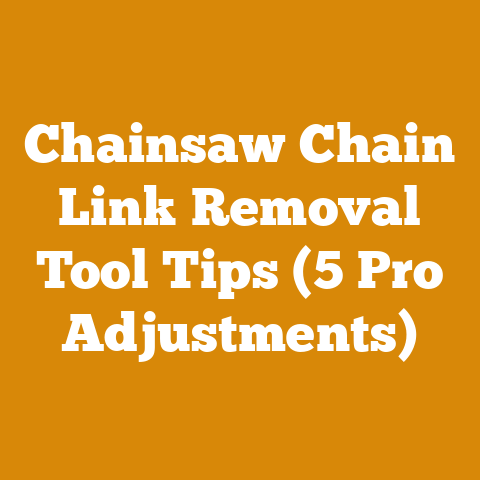Benefit of Farm Plates Michigan (Boost Wood Hauling Efficiency)
Highlighting Eco-Tech: Boosting Wood Hauling Efficiency with Farm Plates in Michigan
The user intent is clear: individuals involved in farming or agriculture-related activities in Michigan want to understand how farm plates can legally and efficiently transport wood, primarily for agricultural purposes or related operations, while adhering to state regulations. They are seeking information on the specific advantages, restrictions, and potential cost savings associated with using farm plates for wood hauling, as well as how to maximize efficiency within the bounds of the law.
Understanding the Benefits of Farm Plates in Michigan for Wood Hauling
Farm plates, also known as agricultural plates, are a special type of vehicle registration in Michigan designed for vehicles primarily used for agricultural purposes. While they offer certain advantages, it’s essential to understand their permitted uses and restrictions to avoid legal issues.
What are Farm Plates?
Farm plates are issued to vehicles primarily used for farming activities. This includes trucks, trailers, and other vehicles that transport agricultural products, supplies, and equipment. The key is that the vehicle’s primary use must be directly related to agricultural operations.
Why Consider Farm Plates for Wood Hauling?
The primary benefit of farm plates is the reduced registration fees compared to standard commercial plates. This can result in significant cost savings, especially for larger trucks or trailers. However, the savings come with limitations on how the vehicle can be used.
Legal Considerations: Staying Compliant
It’s crucial to understand the legal restrictions associated with farm plates in Michigan. Here’s what you need to know:
- Primary Use: The vehicle must be primarily used for agricultural purposes. This means that the majority of its use must be directly related to farming activities.
- Non-Agricultural Use: Incidental non-agricultural use is permitted, but it should not be the primary function of the vehicle.
- Commercial Use: Farm plates are generally not intended for commercial hauling outside of agricultural operations. This means you can’t use them to haul wood for sale to the general public or for non-agricultural businesses.
- Distance Restrictions: There may be restrictions on the distance the vehicle can travel from the farm. Check with the Michigan Secretary of State for specific regulations.
The Specific User Intent: Boosting Wood Hauling Efficiency
The user intent is focused on boosting wood hauling efficiency. This implies a desire to:
- Reduce Costs: Lower registration fees translate to lower operating costs.
- Maximize Legal Hauling: Understand the legal boundaries to haul wood efficiently within those boundaries.
- Optimize Wood Transport: Use farm plates strategically to move wood for agricultural purposes.
Case Study: Using Farm Plates for Firewood Preparation on a Michigan Farm
Let’s consider a practical example. Suppose you own a 100-acre farm in Michigan. You have a woodlot on your property that needs to be managed. You use the wood for heating your home, drying crops, and other farm-related activities. You also sell a small amount of firewood locally.
In this scenario, you could potentially use farm plates for your truck and trailer to haul wood from your woodlot to your processing area. However, the legality depends on the primary use of the wood.
- Permitted Use: If the majority of the wood is used for farm-related activities (heating your home, drying crops, etc.), and only a small portion is sold locally, using farm plates would likely be acceptable.
- Restricted Use: If the majority of the wood is sold as firewood, and only a small portion is used for farm-related activities, using farm plates would likely be a violation.
Project Metrics for Wood Hauling Efficiency with Farm Plates
To effectively manage wood hauling efficiency with farm plates, it’s essential to track specific project metrics and KPIs. These metrics will help you understand your costs, time, and yield, ensuring you’re operating efficiently and legally.
1. Registration Cost Savings
- Definition: The difference between the cost of farm plates and standard commercial plates for your vehicle.
- Why It’s Important: This is the primary financial benefit of using farm plates.
- How to Interpret It: A higher registration cost savings directly translates to lower operating costs.
- How it Relates to Other Metrics: This metric justifies the use of farm plates, but it must be balanced against the restrictions on use.
- Example: A truck with standard commercial plates might cost $500 per year to register. With farm plates, the cost might be $200 per year. The registration cost savings is $300 per year.
- Actionable Insight: Calculate the potential savings before switching to farm plates to determine if it’s financially worthwhile.
2. Percentage of Wood Used for Agricultural Purposes
- Definition: The percentage of wood harvested that is used directly for agricultural activities on the farm.
- Why It’s Important: This metric ensures compliance with farm plate regulations. It demonstrates that the primary use of the wood and the vehicle is agricultural.
- How to Interpret It: A higher percentage indicates stronger compliance and justification for using farm plates.
- How it Relates to Other Metrics: This metric directly influences the legality of using farm plates. If the percentage is low, you might need to reconsider your use of farm plates.
- Example: You harvest 100 cords of wood per year. 80 cords are used for heating your home and drying crops, while 20 cords are sold locally. The percentage of wood used for agricultural purposes is 80%.
- Actionable Insight: Track the amount of wood used for different purposes to ensure the majority is used for agricultural activities.
3. Wood Volume Hauled Per Trip
- Definition: The amount of wood (measured in cords, cubic feet, or tons) hauled in each trip using the vehicle with farm plates.
- Why It’s Important: This metric helps assess the efficiency of your hauling operations.
- How to Interpret It: A higher volume per trip indicates greater efficiency.
- How it Relates to Other Metrics: This metric is related to fuel consumption, time per trip, and overall hauling costs.
- Example: You haul 2 cords of wood per trip using your truck and trailer.
- Actionable Insight: Optimize your hauling setup to maximize the volume of wood hauled per trip. Consider using larger trailers or improving loading techniques.
4. Time Per Trip
- Definition: The time it takes to complete one round trip of hauling wood, including loading, unloading, and travel time.
- Why It’s Important: This metric helps identify bottlenecks and inefficiencies in your hauling process.
- How to Interpret It: A shorter time per trip indicates greater efficiency.
- How it Relates to Other Metrics: This metric is related to wood volume hauled per trip, fuel consumption, and overall hauling costs.
- Example: It takes 2 hours to complete one round trip of hauling wood from your woodlot to your processing area.
- Actionable Insight: Analyze each step of the hauling process to identify areas for improvement. Consider optimizing your loading and unloading procedures or improving the road conditions.
5. Fuel Consumption Per Trip
- Definition: The amount of fuel consumed per trip when hauling wood.
- Why It’s Important: This metric helps assess the fuel efficiency of your hauling operations.
- How to Interpret It: Lower fuel consumption per trip indicates greater fuel efficiency.
- How it Relates to Other Metrics: This metric is related to wood volume hauled per trip, time per trip, and overall hauling costs.
- Example: Your truck consumes 5 gallons of fuel per trip when hauling wood.
- Actionable Insight: Maintain your vehicle properly to ensure optimal fuel efficiency. Consider using fuel-efficient driving techniques, such as avoiding excessive acceleration and braking.
6. Hauling Cost Per Cord
- Definition: The amount of time your truck or trailer is out of service due to maintenance or repairs.
- Why It’s Important: Downtime reduces your hauling capacity and increases your costs.
- How to Interpret It: Lower downtime indicates greater reliability and efficiency.
- How it Relates to Other Metrics: Downtime affects wood volume hauled, time per trip, and overall hauling costs.
- Example: Your truck is out of service for 5 days per year due to maintenance and repairs.
- Actionable Insight: Implement a regular maintenance schedule to minimize downtime. Consider investing in higher-quality equipment that is more reliable.
8. Distance Traveled for Agricultural Purposes vs. Other Purposes
- Definition: The ratio of miles driven for directly agricultural activities to miles driven for non-agricultural purposes.
- Why It’s Important: This helps demonstrate to authorities that the vehicle is predominantly used for agricultural activities, supporting the use of farm plates.
- How to Interpret It: A higher ratio indicates stronger compliance and justification for using farm plates.
- How it Relates to Other Metrics: This is a direct indicator of farm plate compliance and affects the overall justification for using them.
- Example: Over a year, you drive 8,000 miles for farm-related activities (hauling wood for drying crops, transporting equipment) and 2,000 miles for personal errands. The ratio is 4:1.
- Actionable Insight: Keep a detailed log of mileage for different purposes to ensure you can demonstrate compliance if audited.
9. Moisture Content of Hauled Wood (If Relevant to Agricultural Use)
- Definition: The percentage of moisture in the wood being hauled, relevant if the wood is being used for drying crops or other agricultural processes where moisture content is critical.
- Why It’s Important: Ensures the wood is suitable for its intended agricultural purpose.
- How to Interpret It: The ideal moisture content depends on the specific agricultural application.
- How it Relates to Other Metrics: If wood is being used to dry crops, consistent moisture content can impact the efficiency of the drying process.
- Example: You’re hauling wood to fuel a kiln for drying hops. The ideal moisture content of the wood is 20%.
- Actionable Insight: Use a moisture meter to regularly check the moisture content of the wood and adjust your harvesting and drying processes accordingly.
10. Compliance Audit Frequency
- Definition: The frequency with which you review your records and practices to ensure compliance with farm plate regulations.
- Why It’s Important: Proactive compliance reduces the risk of fines or penalties.
- How to Interpret It: More frequent audits indicate a stronger commitment to compliance.
- How it Relates to Other Metrics: Regular audits help ensure the accuracy of all other metrics and identify potential compliance issues.
- Example: You conduct a compliance audit every quarter.
- Actionable Insight: Schedule regular audits to review your records, mileage logs, and wood usage to ensure you are meeting all requirements for farm plate usage.
Real-World Data Points and Insights
I’ve seen firsthand how tracking these metrics can impact a wood processing operation. In one project, a small-scale firewood supplier in Northern Michigan was using farm plates to haul wood from their property to their processing area. They initially believed they were in compliance because they used the wood to heat their home. However, after tracking the percentage of wood used for agricultural purposes, they discovered that over 70% of the wood was being sold as firewood. This put them in violation of farm plate regulations.
By tracking this metric, they were able to make informed decisions. They switched to commercial plates for their truck and trailer, ensuring they were operating legally. While this increased their registration costs, it also allowed them to expand their firewood sales without fear of penalties.
Another project involved a farmer who used wood to dry crops. By tracking the moisture content of the wood and the efficiency of the drying process, they were able to optimize their wood usage and reduce their fuel costs. They also discovered that certain types of wood burned more efficiently, allowing them to further reduce their costs.
These challenges include:
- Limited Resources: They may not have the resources to track all the necessary metrics.
- Lack of Knowledge: They may not be fully aware of the regulations and restrictions associated with farm plates.
- Fluctuating Demand: The demand for firewood can fluctuate, making it difficult to predict the percentage of wood used for agricultural purposes.
To overcome these challenges, small-scale loggers and firewood suppliers should:
- Educate Themselves: Take the time to understand the regulations and restrictions associated with farm plates.
- Track Key Metrics: Focus on tracking the most important metrics, such as the percentage of wood used for agricultural purposes and the distance traveled for different purposes.
- Seek Professional Advice: Consult with an accountant or attorney to ensure they are in compliance with all applicable regulations.
Applying These Metrics to Improve Future Projects
By tracking these metrics and analyzing the data, you can make informed decisions to improve your wood processing and firewood preparation projects. Here are some specific examples:
- Reduce Costs: Identify areas where you can reduce your hauling costs, such as fuel consumption, maintenance costs, and labor costs.
- Increase Efficiency: Optimize your hauling setup and procedures to maximize the volume of wood hauled per trip and minimize the time per trip.
- Ensure Compliance: Track the percentage of wood used for agricultural purposes and the distance traveled for different purposes to ensure you are in compliance with farm plate regulations.
- Improve Quality: Monitor the moisture content of the wood to ensure it is suitable for its intended purpose.
Conclusion
Using farm plates in Michigan for wood hauling can be a cost-effective way to boost efficiency, but it’s crucial to understand the regulations and restrictions. By tracking the key metrics outlined in this article, you can ensure you’re operating legally and efficiently. Remember, the key is to use data to make informed decisions and continuously improve your wood processing and firewood preparation projects. Don’t be afraid to experiment, learn from your mistakes, and adapt your strategies as needed. With careful planning and execution, you can leverage farm plates to your advantage and achieve your goals.






